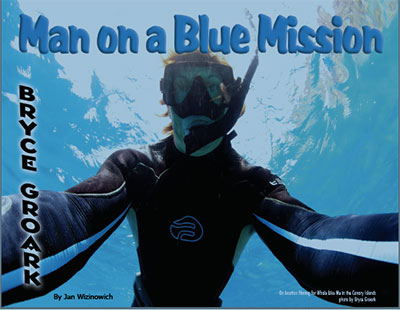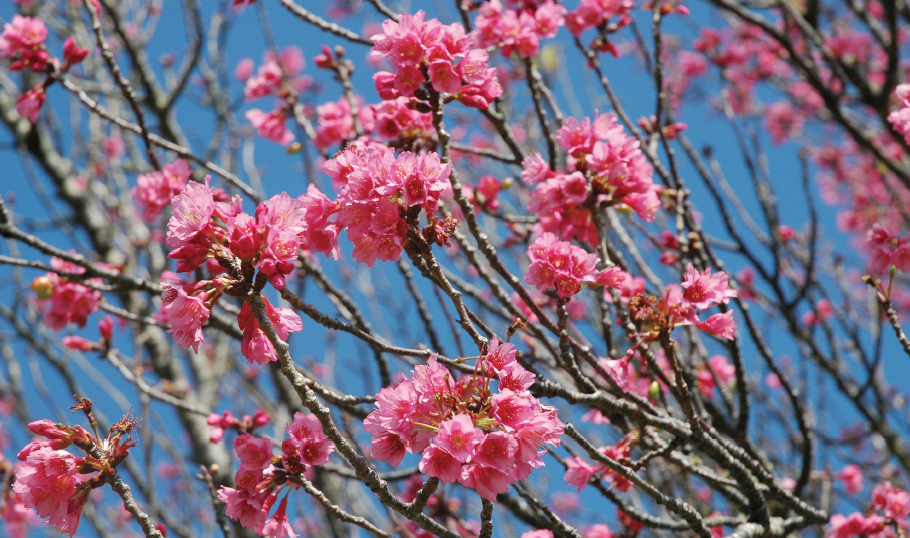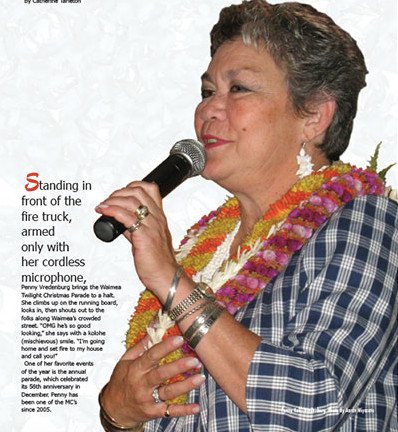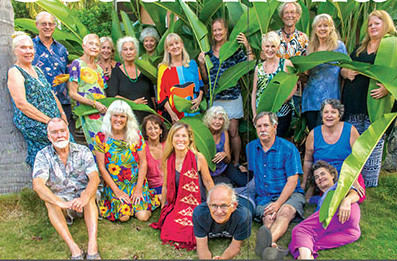
Man on a Blue Mission: Bryce Groark
 Chances are if you’ve ever been on the Fair Wind snorkel boat, you’ve sat in on a Bryce Groark fish class. Although Bryce’s cinematography and marine research work takes him all over the world, his roots are in Kealakekua Bay. His long journey there was fueled by his passion for sharks and a quest for science knowledge that began on Kaua‘i, coming full circle to settle on Hawai‘i Island.
Chances are if you’ve ever been on the Fair Wind snorkel boat, you’ve sat in on a Bryce Groark fish class. Although Bryce’s cinematography and marine research work takes him all over the world, his roots are in Kealakekua Bay. His long journey there was fueled by his passion for sharks and a quest for science knowledge that began on Kaua‘i, coming full circle to settle on Hawai‘i Island.
Growing up landlocked in Missouri, it wasn’t until college that his ocean soul came alive. “I spent a year in Australia and realized that people actually live on the beach, and that was it for me,” says Bryce. Although his true love was marine science, he earned a degree in finance from SMU and worked as a stock trader in the Dallas/Fort Worth area, all the while dreaming of the ocean. “I subscribed to SCUBA magazine, and any time I made some money, I would go to Mexico or Costa Rica for the weekend and go scuba diving,” he recalls.
Eventually, Bryce moved to Fort Lauderdale and spent four months training to become a scuba instructor. When he was done with his course work, he had two job offers. One in the Caribbean and the other on Kaua‘i. While in the process of deciding, one of his instructors who had lived on Maui for 30 years told him, “You belong in Hawai‘i.”
Bryce spent almost two years as a scuba guide and instructor on Kaua‘i’s Na Pali Coast and one day his boss handed him an underwater video camera. “The moment I was underwater with that camera in a cavern with a pregnant white tip reef shark, I was thinking, this is why I became a scuba instructor.” says Bryce.
Next, Bryce and his wife, Jen, headed to S.E. Asia where
they spent a year backpacking and scuba diving with sharks on remote reefs. “We carried hardly anything with us except for a few clothes. Our back packs were 90% scuba gear,” says Bryce.
Still in search of a way to support himself while doing what he loved, Bryce kept applying for jobs, and a degree in finance didn’t get him anywhere. “I only heard back from three people, and they told me that even people with PhDs would have trouble getting these jobs. So I wrote this guy Samuel Gruber, who’s a legendary shark scientist, with a sob story about how nobody would give me a job and how much I loved sharks,” says Bryce.

Gruber gave him a chance and in three weeks Bryce was in the Bahamas. “We were working with lemon sharks, bull sharks, and tiger sharks, catching and tagging them and monitoring their diets. It was an amazing experience. I fell in love with the science,” says Bryce.
After working with sharks in the Bahamas, Bryce was inspired to seek a PhD in Zoology from University of Hawai‘i at Mānoa. “Unfortunately, we only lasted 36 hours in Honolulu. We’d never been to the Big Island and we decided to go there for a week. We came to [Kailua] Kona and that was it,” says Bryce.
His search for work underwater led him to the Fair Wind snorkel boat that runs from Keauhou to Kealakekua Bay. Bryce created Living Ocean Productions and began filming in Kealakekua Bay. “I was reading fish books like crazy. I’d read a behavior in Hoover’s fish book and then go film it. While the tourists had lunch, I’d be off just looking for behaviors,” says Bryce.
Those hours of observation and filming were transformed into a series of intriguing stories that, to the delight of the passengers, became the daily reef ecology class on the Fair Wind. Bryce talked about these creatures as if they were his family, which in a sense they were. “Behaviors make it interesting and correlate to our daily lives. We changed lives with that class and inspired people to care more about the ocean. They still have it on the Fair Wind. I’m pretty proud of that,” says Bryce.
The time he spent on the Fair Wind and in Kealakekua Bay were foundational for him. “I started to see the reef differently. Every little component and nook and cranny. I’d go to 120, 130 feet by myself and I would just sit. That time I spent in Kealakekua Bay by myself every day just brought me to a level that I don’t think I could be who I am today without that,” says Bryce.
All the while he was observing and filming in Kealakekua Bay and giving fish classes on the Fair Wind, Bryce still had his sights set on marine science cinematography. “I’m trying to figure out how to film for National Geographic. If I wasn’t going to get a PhD, I wanted to film the guys who have PhDs. I started to build a library of behaviors and I started getting calls from film crews for fill-in stock footage,” says Bryce.
One day Bryce wondered, “How am I going to know what it’s like to film 500 hammerheads at a time if I’ve never been there or done something like that? Who’s going to give me that job?” That’s when Bryce and Jen decided to take the plunge, literally, and went on a series of trips to rare animal dream places. We’d go for things that were really unique and really big. We went to Mexico, to Islas de Revillagigedo where giant pelagic manta rays are common and seven species of sharks can be seen on one dive. We went back to the Bahamas, a place where there were giant tiger sharks, guaranteed,” says Bryce.
There was no plan to create a movie, just a passion to shoot film footage of large pelagic marine life. It was those filming experiences and concerns for the depletion of the world’s shark populations, one of the biggest threats to the well-being of the marine environment worldwide, that were the basis for the creation of the award-winning shark documentary, Requiem.
Released in 2007 and shown at the 2011 Waimea Ocean Film Festival, Requiem “Was one of the early movies showing sharks as they are and not this huge killing, eating machine. We made it in a few weeks and just sent it to a few film festivals. People were wanting to fly Jen and me to film festivals and all of a sudden we were film makers. To this day, I think it has played in 61 different countries,” says Bryce.
Bryce’s experience and knowledge and ability to interpret science for the non-scientist, has made him a bridge that allows anyone to access and understand the marine ecosystem and hopefully contribute to preserving it, which is how the Ocean Preservation Alliance (OPA) came about.
“I sailed from Egypt to the Sudan on this multi-million dollar yacht and it felt like we just lit money on fire the whole way. Then a few weeks later I was on a job doing a shark film with a National Geographic scientist and he says, ‘If I only had 7,000 more dollars, we could have three more tags and we could have gotten all this extra information,’” says Bryce.
Stunned by this revelation, Bryce and his OPA partner Sean Dooley devised a plan to, “Pick amazing places in the world and present them to yacht owners. We would recommend that they bring these scientists who are the world’s biggest manta ray and shark experts of that area. We would spend all day diving and doing work and then at night we’d have these incredible dinners. At the end of the trip, these billionaires would be like, ‘How do we save this place?’,” he says.
What’s really special about the connections Bryce makes is that he honestly wants to learn about and understand other perspectives. He worked two years creating a Discovery Channel TV series called, Fish Mountain (never aired) by spending time on Hawai‘i fishing boats going out to the Cross Seamount. “I went and met all these local commercial fishermen who are under fire big time here every single day, and I asked them to tell their story. I wanted to know what’s going on out there and I didn’t want to judge,” says Bryce. “I wanted to understand why people do things in certain ways and by doing that I think I’ve broken through barriers and walls.”
In 2010, Bryce had an opportunity to meet world renowned marine conservationist Sylvia Earle. Sylvia had won the TED Prize that year and had gathered 100 of the world’s most influential people on a boat in the Galapagos for five days to create a think tank focused on unique solutions for the earth’s endangered marine ecosystem. For Bryce, this began the four year odyssey that became Mission Blue (2014), screened at the 2015 Waimea Ocean Film Festival.
While on that boat, Bryce was able to make a direct connection between think tank and action. Senator Clayton Hee, Stefanie Brendl and many others had been working hard on SB 2169, a shark finning ban, which eventually was signed into law. “I get this email from Stefanie Brendl that the vote is on the next morning at nine, and she was wondering if I could get any of the influential people on the boat to help us with this. I went to Sylvia, told her what was happening and said, ‘If I could deliver 50 or 60 world class signatures, that would be pretty powerful.’ And she said, ‘I love it. That’s why we’re here. Let’s do it,’” says Bryce.
Despite his awareness of the dire state of the marine environment, Bryce is positive. “I feel like there’s a shift. Fifteen years ago I couldn’t get anyone to care about saving a shark. Now there’s a 100 NGOs specifically for sharks. It’s starting to be mainstream, and for me that’s massive. I don’t want to just show how bad things are. A lot of my projects that I’m in right now are about hope,” says Bryce.
With his next filming project, Bryce will pursue a dream of hope as he travels to Palmyra Atoll, which is relatively undisturbed by human activity, to observe natural ecosystem processes and the interplay of ocean and land. Bryce describes the concept as, “A love story between the land and the sea and how the land and the sea work together and influence each other, affect each other. We’re becoming so much more aware that we need synergy, man and the planet, and to love the earth a little bit in our lives.”❖
Bryce’s Current Filming Work:
Before the Flood (Oct. 2016). Leonardo DiCaprio’s latest climate change film.
Whale Like Me (2017). Six years in the making, a film about the multi-nation whaling controversy.
Sea of Hope (Jan. 2017). A film about the creation of newly protected areas in U.S. waters, including Papahānaumokuakea.
Contact Bryce Groark: bryce@livingoceanproductions.com
Contact writer Jan Wizinowich: janwiz@gmail.com


